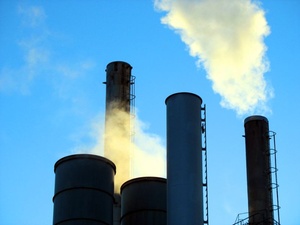
From Ukraine peace plans to Kazakh uranium—all that and more in our new nuclear digest
Our November Nuclear Digest by Bellona’s Environmental Transparency Center is out now. Here’s a quick taste of just three nuclear issues arising in U...
News

Publish date: August 1, 2011
Written by: Anne Karin Sæther
Translated by: Maria Kaminskaya
News
This new comprehensive report, entitled “The Cost of CO2 Capture, Transport and Storage,” was prepared by European Technology Platform on Zero Emission Fossil Fuel Power Plants (ZEP), the European Union’s most authoritative panel on CCS technology.
Set up in 2005 by the European Commission, the panel includes more than 200 influential figures in energy generation, research, and environmental work from all over Europe.
Bellona has long been working closely with ZEP, and in 2007, Bellona President Frederic Hauge was elected the Platform’s vice chairman, a position he still holds.
ZEP’s report examines all the steps involved in employing the CCS technology: capture of carbon dioxide emissions from major emission sources (new gas- and coal-fired power plants); transportation of CO2 (mostly, via pipelines, but also by sea transport); and storage of CO2 in deep underground formations, both on land and under sea.
It states that beginning in 2020 and onward, costs of electricity production from fossil fuels at power plants equipped with CCS technology will be on the same level as those of power generation at offshore wind parks and solar panels.
“The report confirms that CO2 management must play a central role in the fight against climate change in the coming decades,” said Hauge. “A lot has already been done to ensure a solid effort toward cleaning up the power generation sector, but we still need more stringent policy requirements and a continuing funding support in the first several years.”
The European Union already has a relatively ambitious renewable energy policy, with specific requirements and regulations in place to achieve a goal it recently set of having 20 percent of final energy consumption stemming from renewable sources by 2020.
Bellona believes now is the time to form an equally committed policy with regard to CCS:
“This report gives Bellona good grounds to ask the EU to consider similar regulations regarding CCS as there are with respect to renewable energy,” says Hauge.
Last May, Hauge was appointed to advise the EU Energy Commissioner Günther Oettinger on the forthcoming EU Energy Roadmap 2050, an important position that placed him in a fifteen-strong high-level expert group gathered to provide recommendations on reducing greenhouse gas emissions from the European Union’s energy sector.
In this new capacity, Hauge will now be able to use the ZEP report to discuss what incentives and legislative framework may be needed to promote the application of CCS technology.
“One possibility might be to require a steadily increasing share of CO2 capture and storage in countries that operate coal- or gas-fired power plants,” said Hauge. “We must avail ourselves of all the good measures to combat climate change, and renewable energy and CCS take quite a central place among these measures, along with energy efficiency.”
Major European polluters are at present required to buy emission allowances for emitted carbon dioxide. In the short term, however, the costs of buying emission allowances are not high enough for power producers to find it worthwhile to invest in CO2 capture and storage.
But according to the new ZEP report, CCS technology can become a fully competitive commercial technology beginning already in 2025, so long as the emission allowance price reaches at least EUR 35 per tonne of CO2.
Today, the price of emission allowances remains below EUR 20, though it is expected to rise.
To prevent yet another tonne of CO2 from slipping into the atmosphere, EUR 35 is a reasonable price, and far lower than the implicit emission price in many renewable energy support schemes across Europe.
Elsewhere, the ZEP report shows that costs of producing electricity at coal power plants equipped with CCS technology do not differ significantly from those involved in generating power at gas-powered plants fitted with CCS. This is significant for Norway, which has made a political commitment to develop CCS for gas-fired power plants.
”Norway has assumed the responsibility for Europe to gather experience with CCS at gas-powered plants,” said Hauge, adding that for now, nothing specific comes out of that commitment except more planning. “Gas power plants will be used in other places in Europe as well, so Norway must deliver on this count.”
CCS technology is meanwhile set to be put to use on a large scale in Europe, as part of a wide-reaching demonstration programme.
According to these plans, a range of European CCS projects are expected to become operational before the end of 2016, thus helping drive down the cost of this technology.
When the demonstration programme has been completed in the EU, CO2 capture and storage projects will still be expected to rely on subsidies for a period of time – much as renewable energy projects.
But, as Britain’s economist Lord Nicholas Stern famously noted in his ground-breaking report on the economics of climate change, though they seem costly, most of such measures will look quite cheap compared to the costs that the world economy will have to bear if we do nothing to reduce greenhouse gas emissions right now.

Our November Nuclear Digest by Bellona’s Environmental Transparency Center is out now. Here’s a quick taste of just three nuclear issues arising in U...

For three years now, Bellona has continued its work in exile from Vilnius, sustaining and expanding its analysis despite war, repression, and the collapse of international cooperation with Russia in the environmental and nuclear fields

The Board of the Bellona Foundation has appointed former Minister of Climate and the Environment Sveinung Rotevatn as Managing Director of Bellona No...

Økokrim, Norway’s authority for investigating and prosecuting economic and environmental crime, has imposed a record fine on Equinor following a comp...